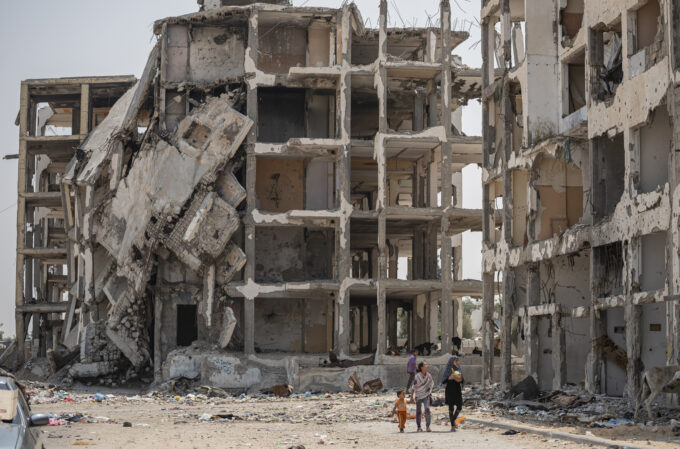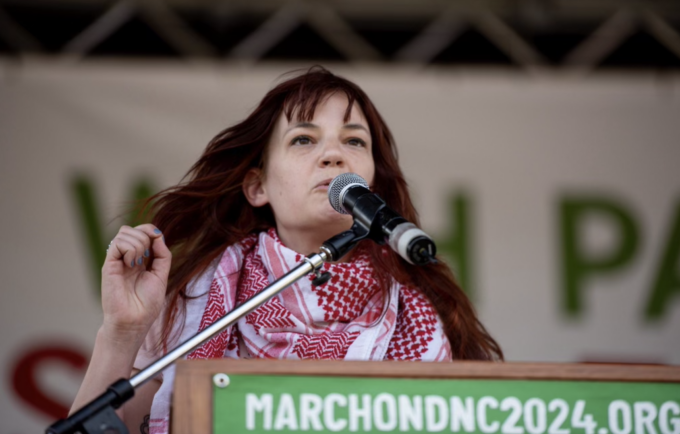
Not the First Time: Family from the Shuja’iyya neighborhood, Gaza City in what remains of their house destroyed by Israel in 2014 during Operation Protective Edge (Photo by Gary Fields).
Since 2007, when the State of Israel implemented its still-ongoing blockade of Gaza, several different monikers have emerged to describe the conditions for Palestinians living in the territory under the ongoing Israeli siege. Now, after 11 months of the murderous Israeli assault on the people of Gaza, it is necessary once again to revise what the State of Israel has imposed on the territory. What the state of Israel has created in the Gaza Strip is nothing less than a death camp akin to what the Nazis created for the massacre of Jews and other so-called enemies of the Reich.
For many years, the descriptor of choice for Gaza emerged – surprisingly — from remarks in 2010 by the former British Prime Minister, David Cameron while on a trip to Ankara Turkey, who described the Gaza Strip as the “world’s largest open-air prison.” Speaking alongside his Turkish counterpart, Recep Tayyip Erdogan, Cameron bluntly insisted that “Gaza cannot and must not be allowed to remain a prison camp.” This characterization of Gaza as a prison bore resemblance to the metaphor used by Michel Foucault to describe the stasis and immobility imposed by authorities on late medieval European towns afflicted by the Plague and became a standard representation of Gaza under the Israeli siege.

Man from the Shuja’iyya neighborhood, Gaza City grieving in the ruins of his house destroyed by Israel in 2014 during Operation Protective Edge (Photo by Gary Fields).
After October 7, 2023, in the initial weeks of the brutal reprisal by the Israeli military against the civilians of Gaza, Masha Gessen in a highly provocative article for the New Yorker, wrote that the prison analogy was no longer applicable to describe what the Palestinians of Gaza were experiencing. Gessen instead insisted on referring to Gaza as a “Ghetto,” and suggested that what Israel was undertaking in Gaza was precisely what the Nazis did in places such as the Ghetto of Warsaw. In what was a courageous, as well insightful observation, Gessen wrote that the Israelis were “liquidating” the Ghetto of Gaza just as the Nazis liquidated the Warsaw Ghetto.
Now, after 11 months of incessant daily bombing and killing of a largely defenseless population with no end in sight; with an entire population, including women and children, made to suffer from no food, no clean water, diseases with no medicines and with the hospitals largely destroyed; and with the civilians of Gaza locked inside the space of the territory with nowhere to flee; the Israeli military is re-creating a project akin to the camps of Treblinka, Sobibor, and Oswiecim but on a larger spatial scale. What else but a death camp corresponds to the organized daily slaughter of Palestinians within a confined space carried out by the State of Israel?

An area of the Shuja’iyya neighborhood, Gaza City destroyed by Israel in 2014 during Operation Protective Edge (Photo by Gary Fields).
In such circumstances, the question that beckons for answers is: how could a nation that claims its heritage from the ashes of the Holocaust and the Nazi death camps — and prides itself on upholding the slogan “never again” — turn around and inflict virtually the same kind of suffering on another group of civilians, and do it seemingly without remorse? While there are no easy answers to this vexing puzzle, surprisingly one place to begin comes from the insights of two contemporaries from the 19th century with vastly different political persuasions.
In his celebrated work, The Ancien Régime and the Revolution (1856), Alexis de Tocqueville asked how the luminaries of the French Revolution, with their “love of equality and the urge to freedom” ultimately crafted a system of authoritarian rule little different from the absolutism they so passionately set out to overturn.* In seeking to explain this paradox, de Tocqueville signaled a beguiling truth about revolutionaries such as Robespierre and St. Just who he insists, “were men shaped by the old order.” These individuals may have wanted to distance themselves from the ancien regime they so fervently wished to destroy, but years of conditioning under French absolutism had influenced their outlook and behavior. Try as they might, these revolutionaries, “remained essentially the same, and in fact…never changed out of recognition.”

The main mosque in the town of Kuza’a (Khan Yunis District) destroyed by Israel in 2014 during Operation Protective Edge (Photo by Gary Fields).
Four years before de Tocqueville’s Ancien Regime, Karl Marx in his Eighteenth Brumaire of Louis Bonaparte, wrote how human beings make their own history, but they don’t make it as they please. They make it “under circumstances directly encountered, given and transmitted from the past.” He used this insight to show not how history repeats, but instead how history “rhymes” as human actors in the present recreate in the present what they have encountered from past experience. Marx famously described the reprise of the past as both tragedy and farce.
In this way, both de Tocqueville and Marx emphasize how human actors emerge from the circumstances around them and in an uncanny way re-enact what they themselves know and have already experienced. What these two towering figures reveal is that history weighs upon the living as they seek to remake the world of the present. What kind of “dead weight” did the Holocaust and the experience of the Nazi death camps cast upon Zionism, Jews, and the State of Israel?
In response to this question, the logical but ultimately naïve impulse is to imagine the victims of the Holocaust filled with compassion for those who have experienced similar fates. Supposedly, those who endured the ravages of the death camps would emerge from their tragedy replete with empathy for the suffering of others. In some cases, this is undoubtedly true.
Far more credible is the disturbing likelihood that the Holocaust produced heirs thoroughly replete with rancor and bitterness toward humanity, with little compassion for other victims of brutality and injustice, and a deeply resentful if not unique sense of victimhood. Indeed, these were hapless victims of an unspeakable state sponsored crime who passed such sentiments of bitterness and resentment to subsequent generations, including the current generation of Israelis who by all accounts of public opinion are fully supportive of the fratricidal activities of their government and seem oblivious to the suffering of their Palestinian neighbors in Gaza. How else is it possible to explain the coarsened cruelty of those Israeli civilians vandalizing aid supplies intended for the starving and suffering people of Gaza, a truly depraved spectacle that conjures up images of the suffering, starving, skeleton-like Jewish captives in the death camps of the Nazis.

Apartment Buildings in Beit Hanoun destroyed by Israel in 2014 during Operation Protective Edge (Photo by Gary Fields).
+++
There is a scene toward the end of the recent award-winning film, The Zone of Interest in which Nazi death camp commanders and various civilian experts are in a meeting, seated around a large table discussing how they will implement the logistics of liquidating a contingent of 700,000 Hungarian Jews who are being transported to the various camp locations. The coldly blunt, even banal dialogue in this scene on the logistical challenges of processing so many bodies for death is obviously an echo of Hannah Arendt’s Banality of Evil. At the same time, the visual imagery in this cinematic re-creation of the meeting is eerily similar to the fleeting images presented on newscasts of the so-called, Israeli “War Cabinet” that usually features the stoic faces of Prime Minister Benjamin Netanyahu and Defense Minister, Yoav Gallant. While we don’t know the exact words exchanged among these Israeli Generals and civilian leaders, the handiwork of this group has been on full display for the world to see for the past 11 months.
In a riveting press briefing of August 26th, two veteran UNRWA officials directly involved in on-the-ground distribution of medical and food aid to the people of Gaza, Louise Wateridge and Sam Rose described a humanitarian catastrophe that they characterized as unprecedented, something they had never seen in decades of UN work. People in places such as Al-Mawasi and Deir al Balah, without food, water, medicines or medical care, are living amid lakes of raw sewage in an apocalyptic landscape of carnage in conditions utterly unfit for human habitation. The situation is worsening by the hour as Israel commands one million starving and sick people to remove themselves again and again — already 16 evacuations in August — and find shelter in a confined space comprising 11% of Gaza that the Israeli military is incessantly bombarding.
Ultimately, the way to comprehend how such a situation described by the two UNRWA officials comes about is to juxtapose the scene from The Zone of Interest on the liquidation of the 700,000 Hungarian Jews, and compare it to the visuals of the Israeli War Cabinet. There is an unsettling symmetry in this comparison that asks us to ponder how the State of Israel has come to this moment in massacring so many thousands of innocents, while keeping those still alive penned in place, readying them for death by preventing them any route of escape.
* For the rest of this paragraph and the next see Gary Fields, “Nazis: The Fraught Politics of a word and a People Besieged.” Jadaliyya.






